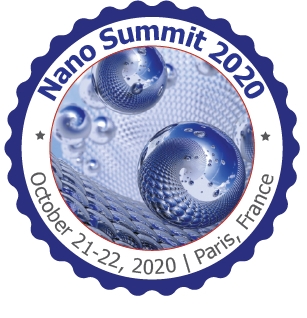
Badis Bendjemil
DGM/FScienTech/Université 08 Mai 1945 de Guelma, 24000 Guelma, Algeria
Title: Carbon Nanotubes produced by hipco Process in Nano Pharmaceuticals Applications
Biography
Biography: Badis Bendjemil
Abstract
During the past years, carbon nanotubes (CNTs) have attracted considerable interest since their first discovery. great progress has been made in the field of nanomaterials given their great potential in biomedical applications. Carbon nanotubes (CNTs), due to their unique physicochemical properties, have become a popular tool in cancer diagnosis and therapy. They are considered one of the most promising nanomaterials with the capability of both detecting the cancerous cells and delivering drugs or small therapeutic molecules to these cells
Because of the unique structure, extremely high specific surface area to-volume ratio enable them to use in an intense real time applications such as detection and treatment of cancerous cells, nervous disorders, tissue repair. and excellent electrical and mechanical properties carbon nanotubes composed of excellent mechanical strength, electrical and thermal conductivities makes them a suitable substance toward developing medical devices., CNTs have been explored in almost every single cancer treatment modality, including drug delivery with small nanomolecules, lymphatic targeted chemotherapy, thermal therapy, photodynamic therapy, and gene therapy and demonstrate a great promise in their use in targeted drug delivery systems, diagnostic techniques and in bio-analytical applications. Majority of the biomedical applications of CNTs must be used after successful functionalization for more potential applications than pristine CNTs. There are several approaches to modify pristine CNTs to potentially active. CNTs poised into the human life and exploited in medical context. Here in, we reviewed the following topics (i) Functionalization of CNTs (ii) CNTs in real time applications such as drug delivery, gene therapy, biosensors and bio imaging; (iii) CNTs 3D printed scaffolds for medicine and (iv) Biocompatability and Biodegradability.
Single-walled carbon nanotubes (SWCNTs) were synthesized using the high-pressure carbon monoxide disproportionation process (HiPCO). The SWCNT diameter, diameter distribution and yield can be varied depending on the process parameters. The obtained HiPCO product present an iron nanoparticle encapsulated heteronanocarbon (core-shell nanoparticles) at low pressure (1 bar) after removing of iron metal catalyst nanoparticle and amorphous carbon by acid immersion and oxidation. The resulting therapeutic molecule in the form of core-shell nanoparticles and single walled carbon nanotubes after functionalization by filling of iron can be use as therapeutic nanomaterials in nanomedicine in diagnosis and treatment of cancer tumor. This paper describes the synthesis method and role of multifunctional nanoparticle in diagnosis and treatment of cancer. Therefore, the aim of this review is to provide basic information on nanoparticles, describe previously developed methods to functionalize nanoparticles and discuss their potential applications in nanobiomedical and mention the therapeutic nanoparticle large scale production and commercialization challenges. In the final part of the review, emphasis is given on the pharmacokinetic aspects of carbon nanotubes including administration routes, absorption mechanisms, distribution and elimination of carbon nanotubes based systems. Lastly, a comprehensive account about the potential biomedical applications has been given followed by insights into the future carbon nanotubes from synthesis to in vivo biomedical applications.

